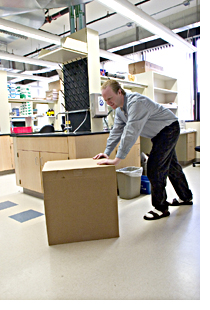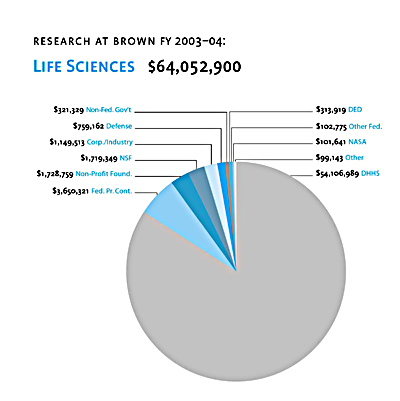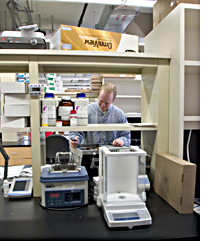|
The lure of the lab: New Ship Street space
is evidence of Brown's commitment to biomedicine
"There's a feeling that the school is taking off - and you're in on the ground floor," says one new occupant.
by Wendy Y. Lawton
Art Salomon is living on Lean Pockets and caffeine-free Diet
Coke. He works 12 hours a day, often on weekends. He doesn't mind. In fact, he
is exhilarated. Salomon is setting up his first laboratory.
The lab is on the third floor of 70 Ship St., Brown's new
biomedical research building. It consists of two equipment rooms and four lab benches
with views of the city's Jewelry District below. Salomon, a 31-year-old
chemist, spent much of August shuttling around this roughly 1,000 square feet
of space, installing incubators, building custom computers, unpacking syringes
and flasks and pipettes.

Chemist Art Salomon moves equipment around his new lab on the third floor of the Ship Street building.
"It's a lot of
work," Salomon says. "But it's a thrill. I've been waiting my whole life for
this."
Getting a lab up and running is a rite of passage for young
scientists. The honor comes after years of academic study and grunt work at
someone else's bench. But space to oversee experiments is usually part of the
package when a scientist accepts a faculty position. With this reward comes
freedom to pursue your own ideas, perfect your techniques, pick your ideal
subjects, whether they're molecules or mice.
But a lab demands responsibility, too. There is a staff to
hire, equipment to order, grants to pursue. The workload is so heavy, in fact,
that most new scientists don't teach during their first year at a university.
"Not getting a
lot of sleep," Salomon reports. He wears a grin regardless.
Ship Street is the first off-campus biomedical research
building Brown has secured in its 240-year history. Richard Besdine, interim
dean of medicine and biological sciences at the Medical School, said the
building helps relieve crowding in campus labs.
 "In 2002, we couldn't even hire replacements for
faculty who were retiring," Besdine says. "There was no place to put
them."
But Besdine said that Ship Street was built to serve another
purpose: attract top-flight scientists. "To recruit good people," he
says, "you have to show them good space."
Unlike most science labs, the five-story building is
spacious, even airy, with its pale wood, high ceilings and wall-to-wall
windows. Work areas feature plenty of computer outlets and storage space; room
between benches keeps faculty and students from being cramped. All of the
equipment is gleaming new, right down to the autoclaves. Even parking is
plentiful.
Salomon raves about Ship Street, particularly the windows:
"If you're in a room that's like a jail cell, it's just not
inspiring." Salomon says the building, which cost the University nearly
$39 million to purchase and renovate, is evidence of Brown's commitment to
biomedicine.
"Brown is building its reputation. There are new
facilities, new people," he says. "There's a feeing that the school
is taking off - and you're in on the ground floor."
The new labs acted as a magnet for many scientists,
particularly a handful of promising young biologists and chemists. Salomon, an
assistant professor in the Department of Molecular Biology, Cell Biology and
Biochemistry, is one of them.
 During his freshman year at Case Western Reserve University,
Salomon found that nicotine protects brain cells from some of the damaging
effects of Alzheimer's disease - a controversial finding that wound up in The
New York Times. It was Salomon's first research paper.
After graduating from Stanford with a doctorate in
chemistry, Salomon went to the Genomics Institute of the Novartis Research
Foundation in San Diego, where he became an ace with a mass spectrometer, a
hulking piece of equipment that uses a superconducting magnet to smash a
peptide, or protein fragment, into even smaller pieces. The machine then
measures the mass of these bits and reveals their sequence and amino acid
modifications in a fraction of a second.
Understanding these modifications is critical because these
changes contribute to disease. Salomon is particularly interested in protein
modifications relevant to type II diabetes, allergies and cancer.

Salomon's shopping list for his new lab included three incubators, two safety cabinets, two refrigerators, two tissue culture hoods and a centrifuge.
"When you find the causes of disease, you find targets
for drugs to treat them," he says. "We are going to be in the
business of curing disease. No single lab will do that. But we're going to
contribute to the effort."
To safely handle cancer and other cells, Salomon ordered a
slew of equipment in June - long before he arrived in Providence. His shopping
list included three incubators, two safety cabinets, two refrigerators, two
tissue culture hoods, and one centrifuge. A new $700,000 mass spectrometer is
on its way.
Because Salomon's work is completely dependent on computers,
which analyze all the data from the mass spectrometer, he ordered high-powered
hardware to customize. The machines are so powerful, they can process 10,000
protein sequences per hour - enough information to fill 1,000 floppy discs.
Salomon has spent the last several weeks building his
computer systems and unpacking hot plates, water bottles, balances. His shelves
are filled with rolls of tin foil - which comes in handy for sterilizing - and
plastic bottles labeled "Terrific Broth." (It's bacteria food.) On a
recent visit, the lab floor was littered with cardboard and shrink wrap.
Along with attending to important but mundane details, such
as securing voice mail, Salomon has been thinking about his staff, which will
include one research associate, two grad students and "as many undergrads
as I can get." Mostly, though, Salomon has spent hours working on a grant
request to the National Institutes of Health. Without money, there's no
science.
"Now it begins," he says. "When you get your
own lab, you get to lead young minds and develop a career. You're starting a
new chapter."
|

